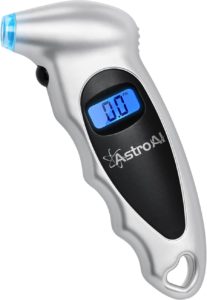Steps to Reset Jaguar F-Pace Tire Light
The Jaguar F-Pace does not have a tire pressure reset button. This makes it essential to learn how to reset your tire pressure warning light.
Step 1: Check Tire Pressure Using Steering Wheel Controls
Select MENU
Select VEHICLE INFORMATION
Select TIRE PRESSURES
The recommended tire pressure values are shown next to your current tire pressures.
Step 2: Adjust Tire Pressure
Fix or Adjust your tire pressures to the recommended pressures. Do this with a tire inflator at your local gas station or a portable tire inflator. Remember to adjust the tire pressure only when the tires are cold. (This means before driving long distances or after the car has been parked for a few hours)
Step 3: Drive
Drive your Jaguar F-Pace for at least 15 minutes to reset the tire pressure monitoring system. The TPMS light on the dashboard will turn off.
Trim Model | Tire Size | Inflation PSI FRONT/REAR |
2016-2024 F-PACE | 235/65/R18 | 34 PSI/34 PSI |
2016-2024 F-PACE | 255/50R20 | 34 PSI/34 PSI |
2016-2024 F-PACE | 265/40R22 | 34 PSI/ 34 PSI |
2016-2024 F-PACE | 255/55R19 | 34 PSI/ 44 PSI |
Jaguar F-Pace TPMS Malfunction Indicator
Your Jaguar F-Pace comes with a TPMS malfunction indicator that alerts you if the system isn’t working properly. This indicator works alongside the low tire pressure warning light. When the tire monitoring system experiences a problem, the warning light will flash for about 75 seconds before staying on continuously. This pattern repeats every time you start your car until the issue is fixed. Basically, if your tire light is flashing and then stays on, your vehicle has lost communication with one or more tire pressure sensors. In short, a flashing tire pressure light signals an issue with the TPMS system itself, not an air pressure problem. So, if you have a defective tire pressure sensor, your TPMS will not function properly. This sequence will also occur if you have a wheel on the vehicle without a sensor in it.

Reset your Jaguar F-Pace TPMS in these Cases:
- After inflating or deflating tires:
When you’ve adjusted the tire pressure to the recommended levels
After rotating tires
After changing to a different set of tires ( seasonal tire change. Make sure both sets of wheels have compatible sensors, or swap them from wheel to wheel)
After tire-related maintenance:
Following a tire repair or replacement
After wheel alignment
When swapping wheels between different positions on the vehicle
In response to TPMS warnings or alerts:
When the TPMS warning light is illuminated on the dashboard
If the TPMS system displays an incorrect tire pressure reading
When the TPMS system indicates a malfunction or communication error
After a change in vehicle load:
If the vehicle’s load capacity has been significantly altered (towing, heavy cargo)
When adjusting tire pressure to accommodate for a change in load
Due to environmental factors:
When there’s a significant change in ambient temperature that could affect tire pressure
After driving on rough or uneven terrain that may have caused pressure changes
After battery-related events:
Following a vehicle battery replacement or disconnection
If the TPMS sensor batteries are low or dying
As part of routine maintenance:
During regular service intervals or inspections
When the vehicle’s TPMS system has not been reset for an extended period or if the F-Pace has been sitting or stored.
How Jaguar F-Pace TPMS Works
- TPMS Components:
Sensors: Each tire (including the spare) is equipped with a TPMS sensor, which measures tire pressure and temperature.
Receiver: The sensors transmit data wirelessly to a central receiver, usually located within the vehicle.
TPMS module: The receiver sends the collected data to the TPMS module, which processes the information and communicates with the vehicle’s onboard computer.
Dashboard display: The vehicle’s instrument cluster or infotainment system displays tire pressure information and alerts.
Data Transmission:
The TPMS sensors transmit data periodically or when triggered by specific events, such as tire pressure changes or temperature fluctuations.
The receiver collects data from all sensors and sends it to the TPMS module for processing.
Pressure Monitoring:
The TPMS module continuously monitors the pressure in each tire and compares it to the recommended pressure levels specified by Jaguar.
If a tire’s pressure falls below or exceeds the recommended range, the TPMS module alerts the driver via the dashboard display with a tire light.
Temperature Monitoring:
The TPMS sensors also monitor tire temperature, which will impact tire pressure.
TPMS Alerts:
Low pressure warning: If a tire’s pressure falls below the recommended threshold, the TPMS warning light will illuminate on the dashboard, and the problematic tire’s location will be displayed.
High pressure warning: If a tire’s pressure exceeds the recommended threshold, the TPMS system will alert the driver and display the affected tire’s location.
System malfunction warning: If the TPMS system detects a malfunction or communication error, it will illuminate a flashing warning light and may display an error message.
Battery Life and Replacement:
The TPMS sensors are powered by built-in batteries, which have a limited lifespan (usually 5-10 years).
When a sensor’s battery is depleted, the TPMS system will trigger a malfunction warning, and the sensor will need to be replaced.

What Causes the Jaguar F-Pace TPMS Light to Turn On?
Low tire pressure: The most common cause, when one or more tires are underinflated, falling below Jaguar recommended pressure level.
Overinflated tires: If a tire is inflated beyond the recommended pressure, it can sometimes cause the tire light to turn on.
Seasonal temperature changes: When the temperature drops, tire pressure decreases in tires. Read more below & see chart
Wheel without sensor: If you replace a wheel be sure to swap over the sensor from the OEM wheel.
Snow and Ice: Excess amounts of snow or ice around the wheels or tire valves
Sensor malfunction: A faulty tire pressure sensor may provide inaccurate readings, triggering the warning light.
TPMS battery issues: A low or dead battery in a tire pressure sensor will cause the system to activate a TPMS malfunction light, explained above.
TPMS malfunction: An issue with the TPMS receiver module will also cause the malfunction indicator.
Radio Interference: Radio frequency interference from devices inside the vehicle or outside the vehicle. (example: alarm systems, aftermarket GPS, or cellular towers can occasionally set off TPMS when driving by)
How Air Temperature Affects Tire Pressure
During winter and colder weather, the ambient air temperature drops, causing tire temperatures to decrease as well. As air temperature falls, tire pressure also drops. This will cause your TPMS warning light to come on more often. The chart above shows the correlation between air temperature and tire pressure changes in both Fahrenheit and Celsius, as well as tire PSI and kPa units. The baseline temperature for checking tire pressure is 62°F (16.7°C), where no real tire pressure changes will occur. Basically, for every 10 degree Fahrenheit drop in air temperature, about 1 Psi air pressure will decrease.
Benefits of TPMS in Jaguar F-Pace
The Tire Pressure Monitoring System (TPMS) in a Jaguar F-PACE offers a wide range of benefits that enhance safety, performance, and convenience for drivers. One of the key advantages is the improved safety it provides by preventing tire blowouts and reducing the risk of tire-related accidents. This is achieved by continuously monitoring tire pressure and alerting drivers when the pressure falls outside the recommended range. It also ensures that the spare tire is properly inflated and ready for use in case of a flat tire.
In terms of performance, the TPMS helps maintain the optimal tire pressure for better traction and grip on various road surfaces. This, in turn, results in proper tire contact with the road, improved handling, and cornering. Furthermore, the TPMS contributes to more even tire tread wear, which prolongs tire life and maintains consistent performance.
Another significant advantage of the Jaguar F-Pace’s TPMS is its ability to enhance fuel efficiency. By reducing rolling resistance through the maintenance of correct tire pressure, the TPMS helps improve fuel economy and allows drivers to save on fuel costs.
As for convenience, the TPMS provides real-time tire pressure information, enabling drivers to address any issues promptly without the need for manual tire pressure checks. This not only saves time and effort but also alerts you to potential tire problems before they escalate into more serious situations, minimizing the chances of unexpected roadside incidents.
Lastly, the TPMS contributes to environmental benefits by promoting proper tire inflation. This results in lower fuel consumption, which in turn leads to reduced greenhouse gas emissions. Additionally, the prolonged tire life due to even tread wear helps lessen the number of trashed tires, thereby reducing the overall environmental impact.
In summary, the TPMS in a Jaguar F-Pace plays a crucial role in ensuring a safer, more efficient, and environmentally friendly driving experience for its users.
Please note that this blog post contains Amazon affiliate links. This means that if you make a purchase through one of these links, we at TPMSRESET.com may earn a small commission at no extra cost to you. We only recommend products that they personally use and believe in. Thank you for supporting this blog.



